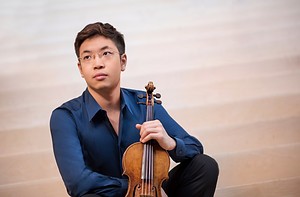Press
Feature
Paul Huang To Perform Bruch’s Scottish Fantasy with the Berliner Symphoniker

On April 27, violinist Paul Huang kicked off a very busy stretch with a Kennedy Center recital with pianist Orion Weiss. The program included Dvorak, Prokofiev, Brahms, and Conrad Tao’s new Threads of Contact.
In May, Huang has Camerata Pacifica concerts at the Colburn School, a two-day visit to the Shaker village of Pleasant Hill in Kentucky, with the Lincoln Center Chamber Music Society in June, and a recital with Wu Han at the Music@Menlo Festival in July. After the Bridgehampton Festival in July, and Jan Vogler‘s Moritzburg Chamber Music Festival & Academy in August, Huang will make his Lucerne Festival debut with Weiss on September 4.
Amidst it all, on June 3, Huang will play Bruch’s Scottish Fantasy with Lior Shambadal conducting the Berliner Symphoniker.
I contacted Huang while he was catching his breath after the DC recital.
Have you ever been to Scotland?
No. But when I played the piece last time, there was a man playing Scottish bagpipes outside of my dressing room on the street. That’s the closest I’ve gotten to Scotland so far with this piece!
How can you play that music without going to Scotland?
I think music is a universal language that has the power to transport us to a different place without physically being there. In fact, Bruch only visited Scotland after he completed the piece. His main inspiration was purely from the folk tunes that he was able to gather in Germany.
How did the Berlin concert happen?
I had worked with maestro Shambadal before in a different city and since he is the chief conductor of the Berliner Symphoniker I must have played OK last time he invited me to Berlin!
How many times have you played the ‘Fantasy’ before?
I lost count. I would say 10-15 times.
How technically challenging is it?
I think it is technically challenging in several moments, especially when you have to jump between high and low registers in very short amounts of time. There are many double-stop passages that are not easy either.
What’s the audience’s response to the piece?
The music is comprised of folk melodies that are so beautiful and memorable, I myself can’t help humming the tunes after hearing it!
What are the interpretive challenges?
I often think of us as being similar to actors, in that our job is to interpret what a composer has written on a piece of paper in black and white. What I have to do is to get in between those notes and decide how to make the music come to life. Once I’ve done that we all react to music differently, and we respond to various kinds of music with different emotions.
What does it take to make that happen?
I think in general the piece has a lot of give and take between the orchestra and the soloist. It is more of a collaborative effort than just a soloist with orchestra accompaniment.
For example, in the second movement, there is a passage where the flute and the solo violin are in parallel motion and requires a great deal of listening and reacting between the two. Same thing with the last movement where the soloist and the harpist have a chamber-music like collaboration. The third movement has a section where the orchestra is in fact the leader of the melody and the soloist is accompanying the melody with a counterpart. In all these magical places, when all things come together, it really is a blissful experience.
The harp plays a very prominent role in the orchestration. Is your best friend the conductor, or the harpist?
I think both! As I mentioned, it is very much a chamber-music collaboration in this concerto. So having a good rapport with all the musicians onstage–the flutist is so important as well as the brass section–can only enhance the outcome of the concert.
Your gear?
I play on a 1742 ex-Wieniawski Guarneri del Gesù violin on loan to me from the Stradivari Society. I have two bows made for me by Benoit Rolland which I often use now in concerts.